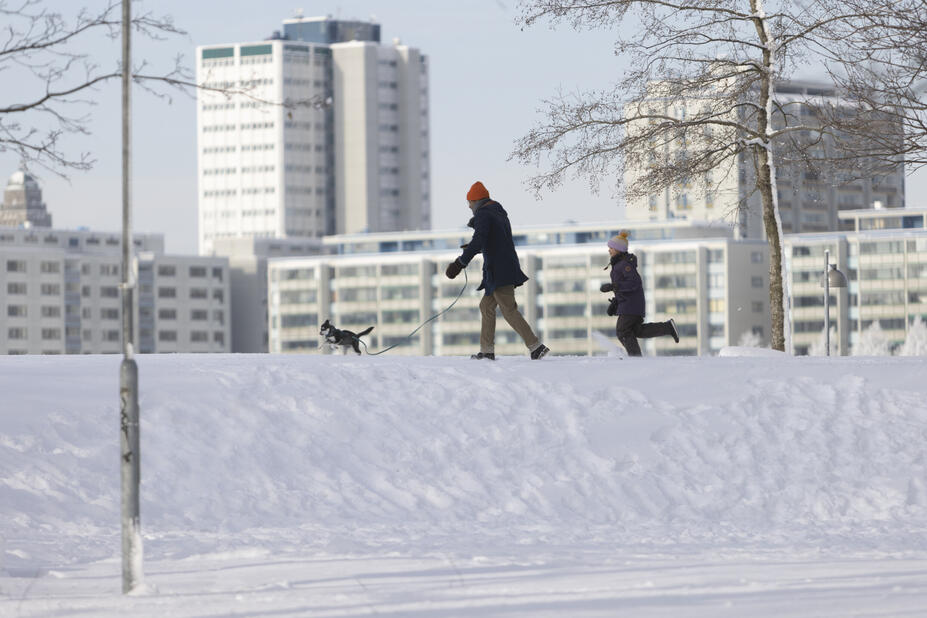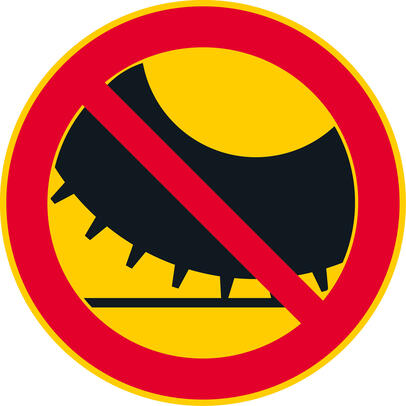
Friction tyres have many advantages
Friction tyres becoming more common benefits city residents and the urban environment in many ways, e.g. through improved air quality.
Street dust is one of the main air quality issues in the Helsinki Metropolitan Area. Exhaust emissions, on the other hand, have decreased in recent years as a result of vehicle technology development and air protection measures.
The main causes of street dust are studded tyres and the damage they inflict on road surfaces. Street dust includes particles from tyres, studs, road surfaces, gritting materials and brakes. All the material that has be broken off during the winter is lifted into the air by traffic as street dust in the spring.
Street dust weakens air quality, especially on busy city streets. City residents who pass through street canyons and live near them are the most exposed to the adverse effects of street dust.
Street dust can be a serious health hazard. High particle concentrations worsen the symptoms of chronic respiratory and cardiac diseases and increase lung infections. Children and seniors in particular are susceptible to these adverse effects. Many asthmatics also have an immediate reaction to street dust.
According to studies, one of the most effective ways to reduce street dust is to increase the share of studless winter tyres in traffic.
Road traffic is the largest source of environmental noise in the Helsinki Metropolitan Area. In winter traffic, studless winter tyres are quieter than studded tyres. An increase in the share of studless winter tyres to 70%, in accordance with Helsinki’s goal, would reduce noise and improve the auditory environment of the city.
In the inner city, the speed limits are relatively low, so the driving noise on the streets does not rise as high as at main road speeds. The impact of studs on traffic noise is at its greatest in the speed range of approximately 50 km/h.
The noise level is also affected by the pavement material in question. An increase in the share of studless winter tyres could allow for the wider use of quieter pavement materials with smaller granules, as studless winter tyres are more gentle on the road surface than studded tyres.
The studded tyres of motor vehicles take a significant toll on the streets of our city and thus increase their maintenance costs. Especially during mild winters, studs excessively break down snowless and often wet road surfaces, breaking material loose from them.
The use of studded tyres causes streets to become rutted, which can constitute a traffic safety risk. In slippery conditions, rutted streets can make it difficult to control the vehicle. An uneven road surface also affects the handling of the vehicle on dry roads, as it weakens the controllability of the vehicle.
Wear caused by studded tyres is by far the most significant reason for the need to repave streets. The main streets may need to be repaved as often as every few years. Studless winter tyres are more gentle on the road surface than studded tyres. As the share of studless winter tyres increases, significant savings will be achieved in winter traffic.
Road traffic is the most significant source of microplastics in Finland. Microplastics generated from traffic are carried into water bodies by transmitters such as run-off waters. You can reduce microplastic emissions from traffic by means such as avoiding unnecessary driving. When you do drive, you should focus on a tyre-saving driving style.
In addition to tyre wear, road traffic microplastic emissions are generated from road markings, from which studded tyres chip off significantly more paint than friction tyres. Accordingly, you can reduce the traffic-generated microplastic load on the environment by choosing friction tyres for winter conditions.
The law does not set any restrictions for the use of friction tyres, meaning that you can have your tyres changed for the winter flexibly in the autumn before roads get slippery and before changing stations become congested.
The Road Traffic Act stipulates that winter tyres must be used from 1 November to 31 March if required by the weather conditions.

Friction tyres in traffic
In winter traffic, safety concerns everyone using the roads. An anticipatory and safe driving style affects traffic safety much more than the type of winter tyres used. The use of friction tyres having become more common has not increased traffic accidents in Nordic reference cities.
Proactive and safe driving style, as well as the condition and quality of the tyres, have a greater impact on road safety than the type of winter tyre.
In winter traffic, all motorists must choose a safe speed for the conditions at hand, be especially attentive when driving through intersections and keep adequate safety distances.
It is important to remember that winter tyres for Nordic use perform significantly better in our conditions than those intended for Central European conditions.
From a safety point of view, studless winter tyres can be recommended for vehicles with an anti-lock braking systems (ABS) and electronic stability control (ESC). ABS has been a standard accessory in passenger cars since 2005 and ESC since 2014.
The use of studless winter tyres has not been shown to increase the number of accidents in Nordic cities, where the majority of winter tyres are studless winter tyres. In Finland, too, the share of studless winter tyres in winter weather accidents has been only 6% in the last decade.
On the other hand, studies show clearly that the grip properties of studded tyres are better on ice, and the grip properties of studless winter tyres are better on snow. In Helsinki, however, difficult ice conditions are considerably rarer than in the rest of the country, and road surface freezing is prevented by anti-skid measures based on de-icing salt. However, driving style impacts safety more than the choice of tyre type.
Tyres are rarely the main cause of traffic accidents. In demanding driving conditions, the risk related to tyres increases, but even then it most often involves the condition of the tyres or, for example, incorrect tyre pressures.
The share of studless winter tyres in Helsinki has risen to 40% (winter 2023–24) from about 30% in previous years. The share of studless winter tyres in the city is monitored by means of surveys and measuring equipment in Tapaninvainio.
In spring 2023, motorists in Helsinki were asked about the use of winter tyres and the choice of winter tyre type. The survey revealed that motorists especially appreciated the suitability of studless winter tyres for urban driving, driving comfort and low tyre noise. Those driving with studless winter tyres also place a much greater emphasis on environmental and health aspects in their choice of tyres than those driving with studded tyres. Those driving with studless winter tyres are also satisfied with their choice of winter tyres, as 80% of them will continue to choose studless winter tyres.
You may also be interested in
More on the topic
Suomen merialueen roskaantumisen lähteet (helsinki.fi) (2020)(Link leads to external service)
Helsingin kaupungin aineistoja, Nastarenkaiden käytön rajoittaminen (2020) (pdf)
Selvitys Helsingin ympäristövyöhykkeen laajentamisen mahdollisuuksista (2019) (pdf)
Helsingin meluntorjunnan toimintasuunnitelma (2018–2022)
Lahti, J., Lähderanta, T. & Räty, E. Nastarenkaiden kuntoerot riskitekijänä. Trafin tutkimuksia 16/2017
Helsingin kaupungin ilmansuojelusuunnitelma 2017-2024 (pdf)
HSY:n Katupöly heikentää ilmanlaatua -sivusto(Link leads to external service)
Hyvän ilman Helsinki -esite (pdf)
Liikenteen ei-pakokaasuperäisten hiukkasten päästöinventaario pääkaupunkiseudulle(Link leads to external service) (pdf) (2015)
Ennakoiva ajotapa, Liikenneturva(Link leads to external service)
Talviajo, Liikenneturva(Link leads to external service)
Renkaat, Liikenneturva(Link leads to external service)
Onnettomuustietoinstituutti OTIn onnettomuustilastot.(Link leads to external service)
Sairanen, H.: Nasta- ja kitkarenkaiden vertailu(Link leads to external service) (2011)
Contact information
You can contact us by email at kymp.ymparistovaikutukset@hel.fi(Link opens default mail program) .
In collaboration with


